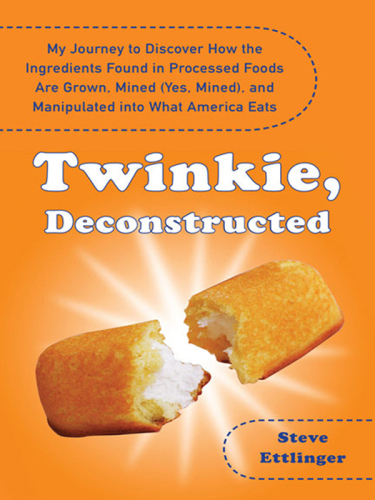
Twinkie, Deconstructed
My Journey to Discover How the Ingredients Found in Processed Foods Are Grown, M
کتاب های مرتبط
- اطلاعات
- نقد و بررسی
- دیدگاه کاربران
نقد و بررسی

January 1, 2007
In this delightful romp through the food processing industry, Ettlinger, who writes on consumer products (The Complete Illustrated Guide to Everything Sold in Hardware Stores
), says, "Believers of urban legends take note.... Twinkies are not just made of chemicals," nor will their ingredients allow them to last, "even exposed on a roof, for 25 years." But what exactly their ingredients are, and how they come from places like Minnesota and Madagascar to be made into what Ettlinger calls "the uber-iconic food product, the archetype of all processed foods," is the subject of his book. Each chapter looks at individual ingredients, in the same order as on a Twinkie package, so Ettlinger finds himself traveling to eastern Pennsylvania farms to study wheat, as well as to high-security plants that manufacture highly toxic chlorine used in minute amounts to make the bleached flour that is "the only kind that works in sugar-heavy" Twinkies or birthday and wedding cakes. His exploration of the manufacturing processes of cellulose gum ("perfect for lending viscosity to the filling in snack cakes—or rocket fuel"), for example, cleverly reveals how Twinkie ingredients "are produced by or dependent on nearly every basic industry we know."

February 1, 2007
Hostess-brand Twinkies® are an iconic American snack food. Who hasn't heard of these cream-filled snack cakes or seen them on grocery shelves? Perhaps it's because of their fame that so many rumors have grown around them. (Do Twinkies® really have an infinite shelf life? Are they really a concoction of chemicals and not actually food?) Ettlinger ("The Hardware Cyclopedia") tackles these rumors, also explaining the tongue-twisting list of ingredients on a package of Twinkies®. Although he is not a food chemist, nutritionist, or any one of a number of people who may be interested in deconstructing Twinkies®, Ettlinger is a concerned father embarrassed at having been unable to answer his children when they asked, "What's Polysorbate 60?" and "Where does Polysorbate 60 come from?" Here he answers their questions while providing an insightful look into the processed food industry. Ettlinger didn't intend this book to discuss the issues surrounding the nutritional value of these constructed foodstuffs, however, so readers looking for support of their particular lifestyle should turn elsewhere. Recommended for all public libraries.Rachel M. Minkin, Graduate Theological Union Lib., Berkeley, CA
Copyright 2007 Library Journal, LLC Used with permission.

























دیدگاه کاربران